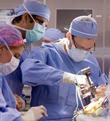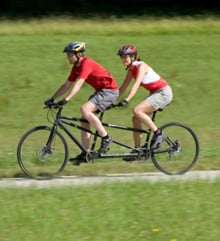

Cleveland Clinic Center for Neurological Restoration |
|
|||||||||||||||||
Dr. Machado Receives NIH New Innovator AwardAndre Machado, MD, Director of Cleveland Clinic’s Center for Neurological Restoration, has received the National Institutes of Health Director’s New Innovator Award and a five-year, $1.5 million grant to fund research in deep brain stimulation (DBS). Dr. Machado was recognized for his research to test the effects of deep brain stimulation for patients with untreatable chronic pain related to strokes or other lesions to the brain. DBS involves placing tiny electrodes in specific parts of the brain and connecting them to brain pacemakers. It has been used for many years to treat patients with movement disorders and is FDA approved for the treatment of Parkinson’s disease and tremor. By electrically stimulating certain networks in the brain, we expect to modulate the pain experience of patients with otherwise intractable pain and, consequently, reduce pain-related disability,” Dr. Advanced Medical and Surgical Options for Movement DisordersCleveland Clinic’s Center for Neurological Restoration has an integrated multidisciplinary team aimed at offering the latest medical and surgical interventions to patients with intractable movement disorders and other neurological impairments. Our multidisciplinary team includes specialized neurologists, stereotactic and functional neurosurgeons, psychiatrists, neuropsychologists, neurophysiologists, biomedical engineers, imaging specialists, researchers, nurse practitioners and physician assistants. Approximately 1.5 million Americans have Parkinson’s disease, including one out of every 100 people over the age of 60. More than 50,000 Americans are diagnosed with Parkinson’s disease each year. The Center for Neurological Restoration is renowned for innovation in the surgical treatment of debilitating disorders such as Parkinson’s disease, essential tremor and dystonia. The center is one of the most experienced in the world at performing deep brain stimulation (DBS), having implanted hundreds of brain pacemakers to improve function and quality of life for treatment-resistant patients. DBS has been shown to be a safe and effective treatment modality for patients with advanced Parkinson’s disease, essential tremor and dystonia. Research into Emerging ApplicationsCleveland Clinic continues to conduct groundbreaking research in neurorestorative therapies for patients with disabilities secondary to neurological and psychiatric disorders. Earning a reputation as a leading innovator in the use of DBS to treat neuropsychiatric disorders, relatively few institutions have the breadth or depth of resources to participate in these collaborative studies:
The scope of our research extends well beyond DBS:
A small study was launched to gauge the effects of “forced exercise” (tandem riding in which patients are forced to pedal 80-90 RPM) on Parkinson’s symptoms. The results were impressive: There was a 35 percent improvement in motor functioning for those patients who did the forced exercise compared to those who pedaled at their own pace. Results lasted four weeks, which suggests the need for continued forced exercise as part of this therapy. By pushing the exerciser past his/her comfort zone by exercising the lower half of the body, it is thought that the upper half improves as well. Further tandem riding studies are now ongoing. To refer a patient to the Center for Neurological Restoration, please call Cleveland Clinic Specialty Services Access Line at 216-738-5439. This line is staffed from 7a.m. – 11p.m., Return to Current Issue | ||||||||||||||||||
Cleveland Clinic | Home | Agenda | Faculty

 Andre Machado, MD
Andre Machado, MD
 X-ray of patient with DBS implant.
X-ray of patient with DBS implant.
 Dr. Machado (far
Dr. Machado (far